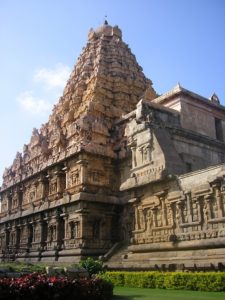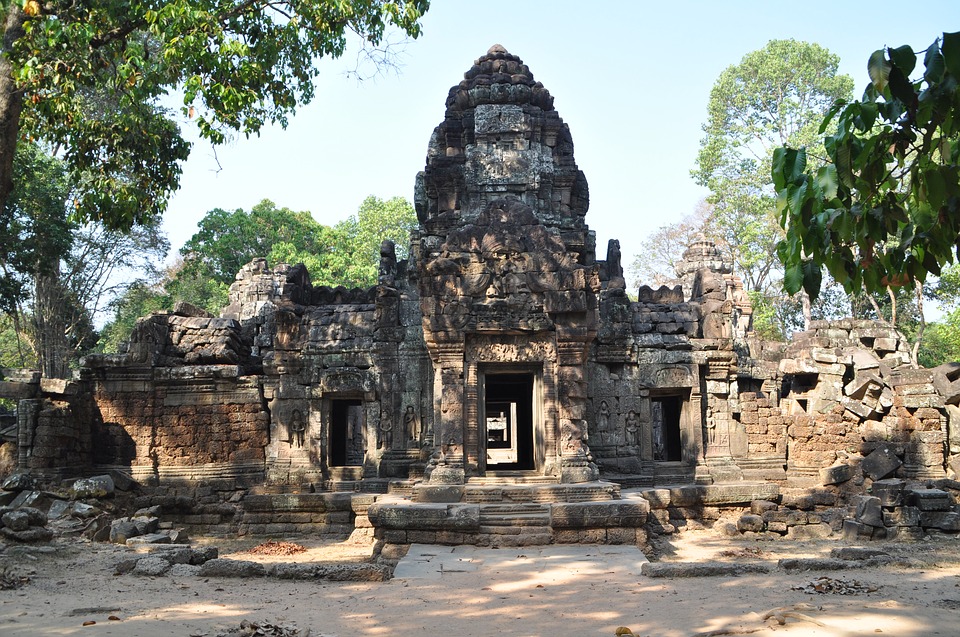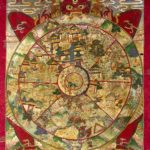Temples in Hinduism, have assumed universal significance today. The very word ‘temple’ has become synonymous with a ‘place of worship’, irrespective of faith. Though it finds no mention in Bhagvadgita and has no place in the original form of Sanatana Dharma, it has become an intrinsic part of Hindu devotion and is symbolic of the Hindu philosophy.
 The symbolism intrinsic in a temple, represents the relationship between man, God, and the universe, as reflected in the architectural norms. It is evident in the very word ‘Nagara’, that is Sanskrit for the temple. Thus the word ‘nartana’ (anatomy of form), ‘gana’ and ‘ranjana’ (sensuality), together make up ‘nagara’, the temple. This is recognized in the ancient architectural tradition, where the Hindu temple represents the different elements of the cosmos.
The symbolism intrinsic in a temple, represents the relationship between man, God, and the universe, as reflected in the architectural norms. It is evident in the very word ‘Nagara’, that is Sanskrit for the temple. Thus the word ‘nartana’ (anatomy of form), ‘gana’ and ‘ranjana’ (sensuality), together make up ‘nagara’, the temple. This is recognized in the ancient architectural tradition, where the Hindu temple represents the different elements of the cosmos.
A paper in the SpringerLink journal ascribes the Hindu temple as representative of the Hindu philosophy, where they are viewed as three-dimensional fractal models, much like that used in computer graphics modelling. The elements of a Hindu temple are thus a symbolic representation of the architectural representation of the world as a microcosm.
The elements
Albeit, the Hindu temple is considered to represent the five elements of the cosmic universe, that forms the core of the temple. However, it seems befitting to include some other elements too, which is an integral part of the external structure of a Hindu temple. So in addition to the Mandala, Garbah-dana, Garbah-griha, Shikhara and Kalas, the rest of the temple structure too conforms to three essential elements. They are the Parikrama, Mandap, and Dwaar, all of which are deemed to welcome the devotee for complete temple darshan.
The Mandala (site)
Site is the primary factor on which a temple is located. Referred to as ‘tirtha’, it is the site favored by the Gods, where there is water, shade, and seclusion. This is where devotees come to take ‘darshan’ of the God whose deity presides in the temple.
The Grabah-griha (sanctum sanctorum)
The Garbah-griha, is the hallowed precincts of the temple that houses the main presiding deity. This is where only the priest is allowed, whose sole duty is serving God and maintaining the sanctity of the sanctum sanctorum. The central square of the ‘mandala’ representing Mount Meru at the centre of the universe, determines the perimeter of this holiest section of the temple. The Garbah-griha is dark, unadorned, as in the womb or Garbah. When a devotee appears in the Garbah-griha to worship the deity, it becomes symbolic of the concept of rebirth and enlightenment.
During construction of a temple, the ritual of Garbah-Dana, has a pot filled with precious jewels and other items necessary to a Hindu ritual, buried below the Garbah-griha. This pot represents germination, growing upwards directly through the ‘sikhara’ and towards the heavens.
The Shikhara (spire)
The Shikhara is positioned directly above the site where the presiding deity is worshipped. It is a high spire-like structure symbolic of the cosmic axis, that begins with the enlightenment at the Grabah-griha and progresses upwards towards the heavens. The Shikhara culminates at the point where the heavens meet the earth.
According to George Michell, the cosmic axis has a mechanical, biological and anthropomorphic connotation, holding up heaven and earth. It acts as the Mount Meru, the universal tree or the vertical spine of the Purusha, man. Summing up, the Shikhara is the spire that enables the meeting of deity and devotee.
The Kalasa (pot)
The Kalasa is the pot, resting on the tip of the Shikhara. Also known as Amalaka, it is an elongated bulb-shaped element resembling a flower bud or flame of a lamp. This is symbolic of new life and growth, the fruition of the Garbah-dana ritual.
Structure
The structure of the Hindu temple follows the rules of ‘Purush Mandala’ while having some additional formats vis-à-vis the structure. Thus, besides the central hallowed precincts, the Grabah-griha, there is the path of Parikrama (circumambulation) surrounding the Garbah-griha on all four sides, the Mandap (Assembly hall) where devotees sit and mediate and the Dwaar (gate) which is the gateway to the entire temple or holy experience.
The core of a Hindu temple represents an inverted tree, where the roots are in the Kalash, the trunk in the Shikhara, branching out to the devotees through the external elements. and reaching the Garbah-griha below for rebirth and germination in Garbah-dana. It beholds the Hindu philosophy that a devotee when in the presence of God, through prayers and meditation, can attain moksha (liberation from all sins) and reach the Heavens.
References:
1. The Hindu Temple: Its meaning, by Rao.
2. The Hindu Temple: An Introduction to its meanings and forms, by George Michell.






